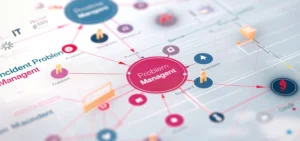The global IT industry is facing a daunting problem – the skills gap.
There are simply not enough trained and experienced IT workers to fill open positions.
Forecasts show that 90% of organizations may suffer a shortage of skilled IT personnel by 2026. This translates to potential loss of an astonishing $5.5 trillion due to service delays and quality issues.
IT teams today are under increasing pressure to deliver services faster, often with less manpower and resources.
So, what should IT leaders do?
Go low code.
No code, low code: “Democratizing ITSM”
Faced with a shortage of skilled IT workers, no-code (NC) or low-code (LC) platforms can offer an excellent ‘workaround’ solution.
No-code platforms enable non-programmers to build workflows via a drag-and-drop method, without writing code. This reduces the need for advanced IT skills and broadens the capabilities of non-IT staff to contribute to ITSM efforts.
Low-code platforms use visual, drag-and-drop features, yet also enable more complex customization via minimal coding as needed. A low-code ITSM platform is ideal for building simple workflows and routine tasks, and at the same time, offers custom functionality with just some technical input from IT staff.
Bottom line: No-code and low-code platforms lower the technical barrier, ‘democratizing’ IT across the organization and helping to fill the IT skill gap.
Beyond ITSM: Expanding into ESM (Enterprise Service Management)
If your IT team is overworked or understaffed, the entire organization pays the price.
IT service performance has a broad impact across the enterprise, from HR to Finance, Legal and Facilities Management.
With a low-code platform, these business teams can automate their own ITSM processes, without any special IT skills, and with minimal input from IT agents.
The advantages of a low-code ITSM platform for ESM are huge:
- Extending ITSM principles to other departments: The processes that guide ITSM, such as request management, incident management, change management, and knowledge management, are expanded to the wider business functions. This will streamline IT workflows and boost efficiency throughout the organization.
- Reduced IT backlog: The ability to set up and manage their own ITSM processes not only empowers other business teams; it also reduces the workload on IT agents, and enables IT to focus on more complex and strategic tasks.
- Agility and responsiveness: With a low-code platform, business teams can handle their own issues quickly when it suits them. There is no need to wait for IT support.
- Unified service experience for employees: With one low-code ITSM/ESM platform, employees and users can benefit from the unified experience across a wide range of service and support functions. For example, HR onboarding, IT ticketing, and reporting a facilities issue are all done from one interface, making it smoother and simpler.
- Easier collaboration between departments: When the organization uses the same ITSM platform, working cross-departmentally is far easier. Business teams are building workflows via the same platform that everyone is familiar with and can access as needed.
- IT governance: With a low-code ITSM platform, IT staff define governance frameworks using templates, role-based permissions, and pre-approved integrations and workflows. Non-IT staff have the freedom to build workflows, while the IT team retains control, compliance, and security.
Low-code ITSM in the real world
According to Gartner research, by 2026, 80% of the user base for low-code development tools will come from outside formal IT departments.
Many organizations are already implementing low-code ITSM platforms, empowering personnel with the ability to develop and customize their own workflows.
IT Care Center, for example, is a low-code ITSM platform that integrates ITIL-based best practices with extended configuration capabilities. This makes customization easy, enabling users to tailor-make any process or workflow based on their department’s needs.
Here are 12 examples of workflows that can be easily created using a low-code ITSM platform like ITCC:
- Automated incident assignment: IT tickets are routed automatically based on categories. Create a workflow with multiple sub-tasks per category and assign them according to flexible conditions or information in the ticket itself.
- Self-service password reset: Create a trigger for an automated password reset workflow that validates the user’s identity and lets them update their credentials without involving an IT agent.
- Request and approval for software access: Employees request access to a software app, triggering an automatic approval request that is sent to the manager. Once approval is given, the license is automatically issued and a notification is sent to the user.
- IT asset onboarding/offboarding: When an employee joins or leaves the company, workflows can be set up to trigger provisioning of assets (i.e., laptop setup, inclusion in email groups, etc) or recovery tasks (i.e., account deactivation, removal of software access).
- Automated IT chatbot for incident resolution: Build a service chatbot to handle common support issues, with automated suggestions for troubleshooting content from the knowledge base. If the problem can’t be resolved by the user, the chatbot creates a ticket and submits it to the helpdesk.
- HR employee onboarding: A new employee form triggers tasks for HR (such as the employee contract and tax documents), IT (setup of accounts and assigning hardware), and Facilities (assigning workspaces, ensuring access to staff parking, etc).
- Facilities maintenance request: An employee submits an issue (i.e., broken window shade). The request is automatically routed to the Facilities service desk, which sets up an automated request to the vendor.
- Expense reimbursement process: An employee uploads a receipt, which is auto-validated based on the defined policy. The request for approval and payment are automatically sent to the Finance department.
- Automated incident escalation: If a ticket is not resolved within a pre-defined SLA, the system automatically escalates it to the next support tier or notifies a team supervisor.
- Service request for new hardware: The user selects the device type (i.e., laptop charger), which triggers an approval request from the relevant manager. Upon approval, an automatic inventory check is completed, and the order is created.
- Knowledge article feedback loop: After a user visits a knowledge base article, the system prompts the user for feedback about the quality of the content. Over time, the ratings are aggregated and low-rated articles are periodically flagged for review.
- License renewal reminders: This workflow tracks software licenses and auto-generates reminders to renew 30 days before expiration. The renewal alert is sent to the responsible owner for each license.
Automation and efficiency: Get started with low-code ITCC
With a low-code ITSM platform, IT staff and non-IT staff alike can use automation to deploy new workflows faster, reduce repetitive manual tasks, and standardize service delivery across business departments, creating a smoother, unified user experience.
Follow these four steps to kickstart your low-code ITSM performance and achieve success:
- Define clear governance and roles within the platform.
- Provide training and support for non-IT users.
- Start small, measure the impact, then scale automation.
- Regularly review workflows and optimize accordingly.
ITCC is proud to be part of the movement towards democratizing ITSM, empowering the IT team and the entire organization with an agile, low-code solution for ITSM, IT Helpdesk, and ESM.
Ready to see how quickly your team can automate IT workflows? Request a 30-minute demo with ITCC.




